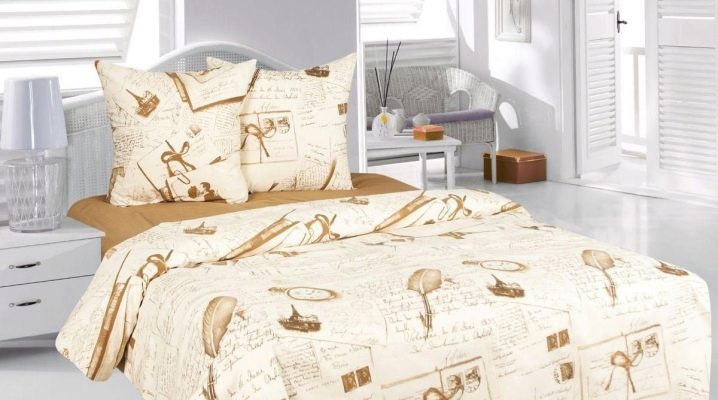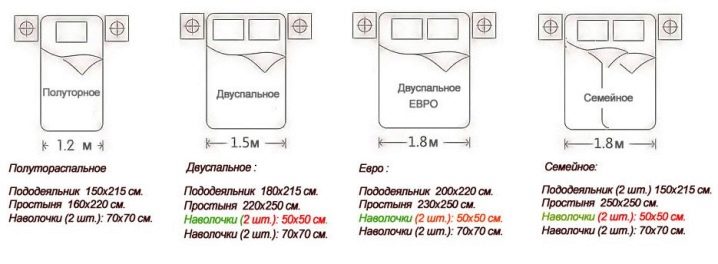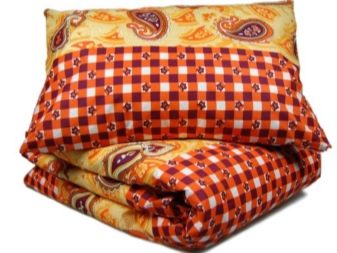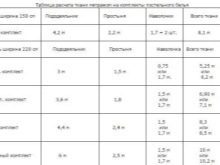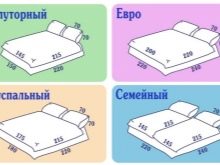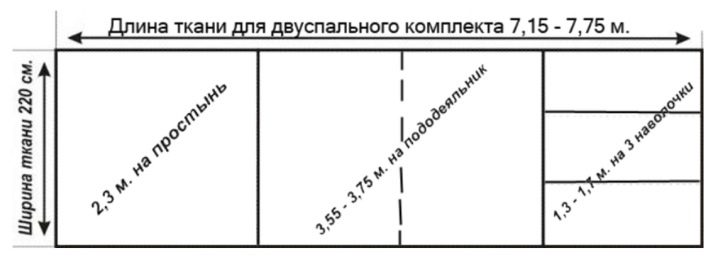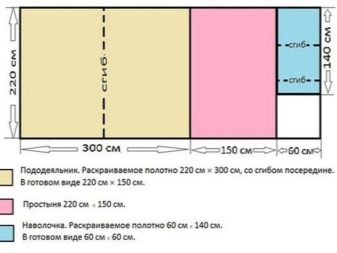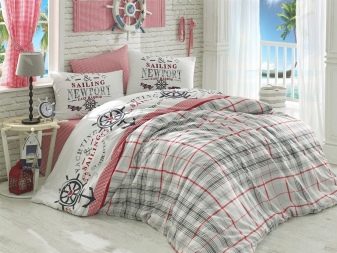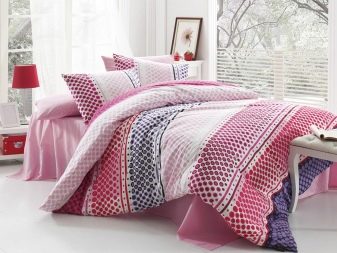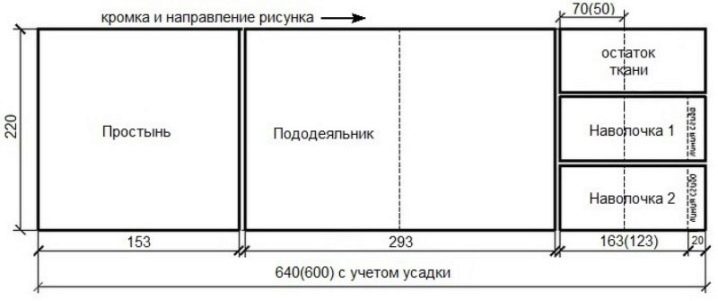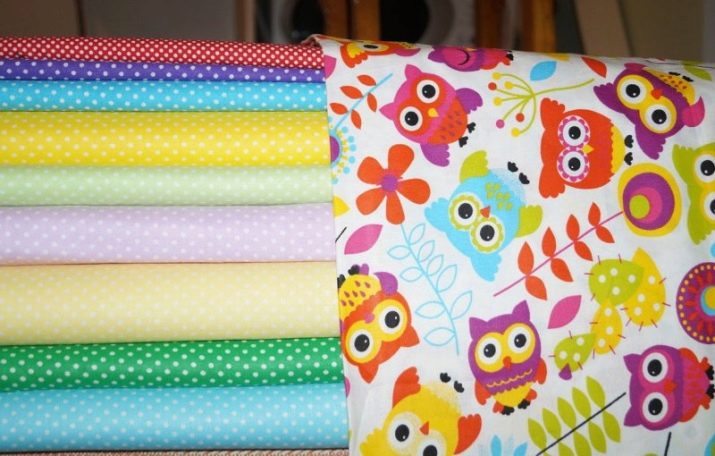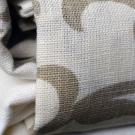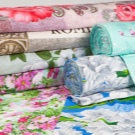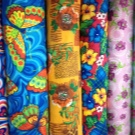Rules for calculating fabric for bedding
For each person to spend an extra minute in a cozy bed on soft sheets under a warm blanket is considered an element of bliss. Especially if the bedding is made of quality material. One touch to the body makes you forget about all the troubles and troubles, having gone on a journey through pleasant dreams.
How many meters do I need for standard kits?
For the modern rhythm of life is very important that night's sleep allows a person to relax and rest. An important role in this matter is played by high-quality bedding. Quite often, many housewives are faced with the problem of the first wash. As soon as the new set has been washed, the fabric turns into dense matter, which becomes unpleasant to touch.
To avoid such incidents, the hostess found the right decision and took the manufacture of bed linen in their hands. At first glance it seems that the process of tailoring sheets, duvet cover and a pair of pillowcases is not difficult. And it will take a little time. But in fact it turns out a lot of time-consuming work.
First, it is necessary to correctly calculate the footage of the bed set. At the same time, it is necessary to take into account an increase in the fabric footage for additional footnotes.
Secondly, it is very important to properly cut. Otherwise, pieces of unused matter may remain, or, conversely, there will not be enough tissue. In order not to look in the old records for the size of the elements of the pattern of bed linen, it is proposed to look at the table.
Duvet Cover | Sheet | |
1 bedroom (150 cm) | 215*143 | 120*203 |
1,5-bedroom (150 cm) | 215*153 | 130*214 |
2 bedroom (220 cm) | 215*175 | 230*138-165 |
Regarding pillows, you will need to do independent measurements, since the choice of each person is based on convenience. Someone uses only rectangular shapes, for others classic square pillows are considered the most comfortable.
To independently calculate the fabric for bedding with a width of 220 centimeters, by the way, the European size, and to find out how much fabric you need to use, you need to solve a simple problem:
- duvet cover 220 cm width + 0.6 cm on the one hand on the seam + 0.6 cm on the other hand on the seam = 221.2 cm width on the one hand, 221.2 cm x 2 = 442.4 cm full size of fabric with stitches;
- sheet 240 cm width + 0.6 cm per seam + 0.6 cm per seam = 241.2 cm full width of the required material.
Double bed
Despite the existence of certain standards for bed linen, various variations of square footage of double sets are put on the market. For example, the size of the duvet cover 200x220, 175x215, 180x210 centimeters. Accordingly, the length and width of the sheet varies 175x210, 210x230, 220x215 centimeters. Pillows, depending on the configuration and form. To understand how much material is required for sewing a double set, you need to take one of the sizes listed below.
- For a duvet cover of 175 cm will be required for one side, the second side corresponds to the size of the first. It is better to roll the fabric and not to cut it. For the manufacture of seams, 5 cm is added. The total is 175x2 + 5 = 355 cm of fabric required for sewing a duvet cover.
- The sheet is much easier to make. To its size 210 cm is added 5 cm on the seams. Total 215 centimeters.
- Pillowcases for example rectangular shape with dimensions 50x70 + 5 cm seam. The total footage is 105 cm. Two pillows, respectively, will take 210 centimeters.
- The final calculation of the fabric expended was 7.8 m.
One and half sleeping
For sewing a one-and-a-half-bedding set of bed linen, the most acceptable sizes are as follows: a duvet cover 150x210 cm, and a sheet 150x200 cm. Next, the total amount of material is calculated.
- For one side of the duvet cover, 155 cm is required, where 150 cm is the distance required by the standard, and 5 cm is added to the seams. The same picture looks for the second side. In general, the tailoring of the duvet cover will require 3.1 m.
- Sheets are made in the same way. The standard 150 cm is increased by 5 cm for the seam. The total is 1.55 m.
- Pillowcases are required to know the size of the available pillows. If we take the option 60x60, we get the following calculations: add 60 cm to the side of the pillowcase and add the second side of the pillowcase and 5 cm for the seams. The result is 1.25 m per pillow.
- The total amount of fabric used for sewing a one-and-a-half bedding set is 5.9 m.
Single bed
There is no big difference between one-and-a-half sleeping and single bed linen sets. The dimensions are almost the same, the only thing that manufacturers can reduce the width of the width by about 20 cm, but no more. Judging by their scheme, you can make an approximate calculation.
- The duvet cover is also 150 cm. It is added 5 cm to the seams and multiplied by two to account for the second side. Total 3.1 m
- Sheet 130 cm. Plus 5 cm seams. A total of 1.35 m.
- The pillowcase, according to the calculation of 60x60, is 125 cm of fabric, where an additional 5 cm is intended for seams.
- In general, it turns out 5.7 m.
How to calculate material for European parameters?
In modern life, the most acceptable option for bed linen are considered to be sets of euros. They can be purchased, and you can sew your own hands, choosing a special material. As regards the dimensions, there are several applicable standards for Eurosets. The most common variant is 220x240 cm. Regarding pillowcases, then depending on the pillows. It can be the size of 50x70 or 70x70 centimeters. To understand what will be the consumption of fabric for the desired size, it is necessary to study the table.
Euroset | The size | ||
2.2 m | 2.4 m | 2.8 m | |
Duvet Cover | 4.85 m | 4.85 m | 4.85 m |
Sheet | 2.45 m | 2.45 m | 2.45 or 2.25 |
Pillowcases with a smell 50 * 70 | 1.1 m / 0.75 m | 1.1 m / 0.75 m | 1.1 m / 0.75 m |
Pillowcases 70 * 70 | 1.5 m / 1.5 m | 1.5 m / 1.5 m | 1.5 m / 1.5 m |
Consider the type of fabric
Having made the decision to sew a set of bed linen yourself, you must first select the fabric. It should be soft, gentle, most importantly, the material chosen for manufacturing should be safe.
- Chintz For this material used a lot of different colors and patterns. The quality of the fabric is easy, touching the body, causes a pleasant feeling. The disadvantage lies in the fineness of the fabric, so you can not count on many years of service.
- Calico. The material is quite dense. The choice of buyers represented a huge variety of colors of this type of fabric. When washing, the paint of the pattern is not washed off, but with constant use the material becomes soft, without losing the strength of the texture.
- Flannel. This type of fabric is mostly used for sewing baby diapers. In all respects, flannel fabric is very much like coarse calico, so it can be used when sewing bed linen.
- Satin. This material differs only positive qualities. It is soft, light and very durable. Quite often, baby sleep sets are made from it. Given the high performance, the cost of sateen is quite high.
- Linen. Fabric differs in the increased durability, belongs to type of hypoallergenic materials. In a color variety flax does not compete with other types of matter, since it is very difficult to paint.
- Silk. The most famous type of fabric. Its characteristics include smoothness and durability. In the color palette has no boundaries. Silk does not cause an allergic reaction and can last for a long time.
Layout and cutting for sewing do-it-yourself
Before starting the main work, it is required to carry out some manipulations with fabric. It must be carefully washed, ironed and ironed with an iron. After these actions, the fabric will shrink. Otherwise, a disproportionate result will be obtained.
For sewing sheets need to make an exact cutting of the fabric. With a desired width of 220 cm, an additional distance for seams is deposited, a maximum of 5 cm. If there are closed edges of the fabric, the width can be not added.For the length of the sheet it is necessary to measure 2.4 m and 5 cm on the allowances on both sides. To begin processing, overlock exposed edges with open cuts. After that, the edges hem up by 2 cm and ironed out to make the work easier. A few millimeters it is necessary to make a line of decorative type. According to this scheme, the sheets are cut with a width of 220 centimeters.
A little more work is needed with the duvet cover. With a width of 220 centimeters, according to preliminary estimates, the fabric came out 4.5 m. The material must be folded in half. For the convenience of subsequent use, it is best to sew between the sides of the duvet cover, and to fill the blanket itself, leave the opened piece on the smaller side. The seam for the open department is best done closed.
Cutting and tailoring of pillowcases is carried out according to individual sizes.
How to calculate the fabric on the bedding, see the following video.
